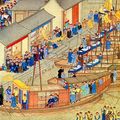
Imperial China 900-1800
Frederick Mote
A major preoccupation of this work by Princeton's highly respected professor emeritus, Frederick W. Mote, is the interplay between China and Inner Asia, a region that includes Manchuria, Mongolia, Xinjiang, and Tibet. This is an important advance on previous broad examinations of imperial China, which have a distinct bias toward sinocentric dynastic politics. The year 907 marked the final breakdown of the Tang government and the establishment of a series of non-Chinese dynasties, from the Liao to the Qing, who ruled over all or much of Chinese territory for the next thousand years. Mote explains the impact on China of the Turkic and Mongol tribes to the north and west, a cultural influence that, for political reasons, is normally neglected by Chinese historians. The book's many excellent maps show how China's boundaries were constrained by powerful neighbors, a fact that also has political significance today. Economic questions are discussed, such as transportation systems and trade with the northern tribes. Environmental issues, such as the silting and flooding of the Yellow River, firmly insert geography into historical studies. Meanwhile, the next edition--and there will surely be another edition--will benefit from a standardized modern romanization of such languages as Mongolian. Imperial China 900-1800 represents the distillation of a lifetime's study by a senior scholar steeped in Chinese history, yet it incorporates recent archaeological discoveries and is up
Booko found 2 book editions
Product filters
| Product |
Details
|
Price
|
New
|
Used
|
|---|---|---|---|---|
|
|
New: Being refreshed...
Used: Being refreshed...
|
New: Being refreshed...
Used: Being refreshed...
|
Being refreshed... | Being refreshed... |
|
|
New: Being refreshed...
Used: Being refreshed...
|
New: Being refreshed...
Used: Being refreshed...
|
Being refreshed... | Being refreshed... |
Booko collects this information from user contributions and sources on the internet - it is not a definitive list of editions. Search Booko for other editions of Imperial China 900-1800.
![Cover Art for B017271H8W, [Imperial China 900-1800] (By: Frederick W. Mote) [published: December, 2003] by Frederick W. Mote](https://bn.bkocdn.info/covers/1cfe07e21f45e54e/v/120x120.jpeg)



















